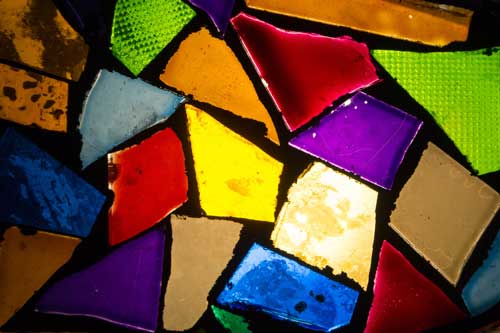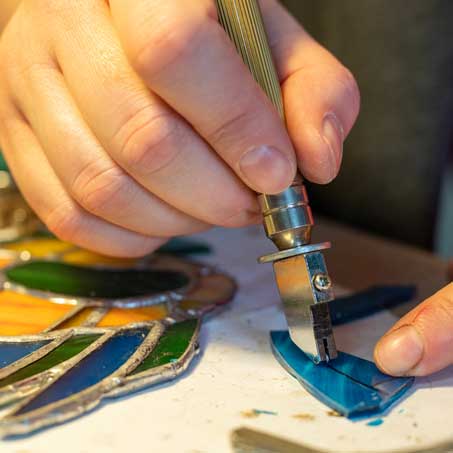The Role of Glass Inlay in Interior Design
Glass inlay has been used for centuries to enhance the beauty of spaces and is still a popular choice in modern interior design. This technique adds color, light, and a touch of elegance to any room. We will explore the role of glass inlay in interior design and how it can transform ordinary spaces into extraordinary ones.

What is the glass inlay technique?

Glass inlay involves cutting and fitting pieces of glass into a surface, such as wood, metal, or stone. The glass pieces can be of different shapes, sizes, and colors, creating intricate patterns and designs. This technique can be used in various elements of interior design, including furniture, walls, flooring, and decorative items.
Modern Applications of Glass Inlay Residential Spaces

In modern interior design, glass inlay is used to add a touch of elegance and uniqueness to residential spaces. It can be found in various applications, including:
● Flooring: Glass inlay in flooring can create stunning visual effects, especially when combined with other materials like marble or wood.
● Wall Art: Custom glass inlay wall art pieces can serve as focal points in living rooms, dining areas, and bedrooms.
● Furniture: Tables, cabinets, and other furniture pieces can be adorned with glass inlay to make them stand out.
Commercial Spaces
Glass inlay is also widely used in commercial spaces to create memorable and visually appealing environments. Some common applications include:
● Hotel Lobbies: Luxurious hotel lobbies often feature glass inlay designs to impress guests and create a sense of grandeur.
● Retail Stores: High-end retail stores use glass inlay in their interiors to create a sophisticated and elegant shopping experience.
● Corporate Offices: Glass inlay can be used in corporate offices to add a touch of professionalism and style.
Benefits of Using Glass Inlay in Interior Design Aesthetic Appeal
Glass inlay adds a unique and artistic element to any space. Its ability to reflect light and create intricate patterns makes it a versatile choice for enhancing the visual appeal of interiors.
Durability
When properly installed and maintained, glass inlay is a durable and long-lasting option for interior design. It can withstand daily wear and tear, making it suitable for both residential and commercial spaces.
Customization
One of the greatest advantages of glass inlay is its customization potential. Designers can create bespoke patterns and designs tailored to the specific needs and preferences of their clients. This level of personalization ensures that each piece is unique and fits perfectly within the intended space.
Versatility
Glass inlay is incredibly versatile and can be used in a variety of settings and applications. From traditional to modern styles, it can complement any design aesthetic and enhance the overall ambiance of a space.
Techniques for Creating Glass Inlay Stained Glass
Stained glass is one of the most common techniques used in glass inlay. It involves cutting pieces of colored glass and assembling them into a pattern. The pieces are then soldered together to create a cohesive design. This technique is often used in windows, doors, and decorative panels.
Fused Glass
Fused glass involves melting pieces of glass together in a kiln to create a single, solid piece. This technique allows for a wide range of colors and textures, making it ideal for creating unique and intricate designs. Fused glass is often used in wall art, jewelry, and decorative objects.
Etched Glass
Etched glass involves using acid or abrasive materials to carve designs into the surface of the glass. This technique can create intricate and detailed patterns, making it a popular choice for decorative windows, mirrors, and glass panels.
Incorporating Glass Inlay into Your Interior Design Choosing the Right Design
When incorporating glass inlay into your interior design, it’s important to choose a design that complements the overall aesthetic of the space. Consider the colors, patterns, and styles that will best enhance the existing decor.
Working with Professionals
Due to the complexity and skill required for glass inlay, it’s essential to work with experienced professionals. They can help you design and execute your vision, ensuring that the final result is both beautiful and functional.
Maintenance and Care
To keep glass inlay looking its best, regular maintenance and care are essential. Clean the glass regularly with a mild, non-abrasive cleaner to prevent dirt and grime buildup. Avoid using harsh chemicals or abrasive materials that can scratch or damage the surface. When properly installed and maintained, glass inlay is a durable and long-lasting option for interior design. It can withstand daily wear and tear, making it suitable for both residential and commercial spaces.
Customization
One of the greatest advantages of glass inlay is its customization potential. Designers can create bespoke patterns and designs tailored to the specific needs and preferences of their clients. This level of personalization ensures that each piece is unique and fits perfectly within the intended space.
Versatility
Glass inlay is incredibly versatile and can be used in a variety of settings and applications. From traditional to modern styles, it can complement any design aesthetic and enhance the overall ambiance of a space.
Techniques for Creating Glass Inlay Stained Glass
Stained glass is one of the most common techniques used in glass inlay. It involves cutting pieces of colored glass and assembling them into a pattern. The pieces are then soldered together to create a cohesive design. This technique is often used in windows, doors, and decorative panels.
Fused Glass
Fused glass involves melting pieces of glass together in a kiln to create a single, solid piece. This technique allows for a wide range of colors and textures, making it ideal for creating unique and intricate designs. Fused glass is often used in wall art, jewelry, and decorative objects.
Etched Glass
Etched glass involves using acid or abrasive materials to carve designs into the surface of the glass. This technique can create intricate and detailed patterns, making it a popular choice for decorative windows, mirrors, and glass panels.
Incorporating Glass Inlay into Your Interior Design Choosing the Right Design
When incorporating glass inlay into your interior design, it’s important to choose a design that complements the overall aesthetic of the space. Consider the colors, patterns, and styles that will best enhance the existing decor.
Working with Professionals
Due to the complexity and skill required for glass inlay, it’s essential to work with experienced professionals. They can help you design and execute your vision, ensuring that the final result is both beautiful and functional.
Maintenance and Care
To keep glass inlay looking its best, regular maintenance and care are essential. Clean the glass regularly with a mild, non-abrasive cleaner to prevent dirt and grime buildup. Avoid using harsh chemicals or abrasive materials that can scratch or damage the surface.
Conclusion
Glass inlay plays a significant role in interior design, offering a blend of beauty, versatility, and durability. It transforms ordinary spaces into extraordinary ones, adding elegance and sophistication. Whether used in furniture, walls, flooring, or decorative items, glass inlay brings a unique and timeless charm to any interior. With proper care and maintenance, glass inlay can be a lasting and valuable addition to your home or office decor.
